Contents
[Introduction] [The history of the Brattingsborgspenningarna]
[Scientific history of the genus Crania and the Brattingsborgspenningarna]
[Conclusion]
[Bibliographic references] [Appendix 1] [Appendix 2] and ... [Figures]
BrachNet
20, Rue Chaix, F-13007 Marseille (France)
Manuscript online since October 31, 2009
The Brattingsborg pennies are mentioned in medieval texts dating from the middle of the first millennium and many popular medieval legends refer to their occurrence on Ivö Island in the Scania region (Sweden) as brattingsborgpenningar or in Latin as Nummulus brattenburgensis. Actually they are valves of the fossil brachiopod Crania craniolaris originally described by (1758) as Anomia craniolaris from the Upper Cretaceous. Later (1781) created the genus Crania based on these specimens from Ivö Island and on another species he described under Crania (now Isocrania) egnabergensis from Ignaberga in the Scania region. The scientific history of those two species is reviewed along with that of Danocrania tuberculata (, 1826), formerly figured as Craniolites brattenburgicus, from the Danian of Scania. Two legends about these "pennies" are included.
Brachiopod; Crania; Isocrania; Danocrania; history; Sweden.
C.C. (2009).- Nummulus brattenburgensis and Crania craniolaris (Brachiopoda, Craniidae).- Carnets de Géologie / Notebooks on Geology, Brest, Article 2009/08 (CG2009_A08)
Nummulus brattenburgensis et Crania craniolaris (Brachiopoda, Craniidae).- Les pences de Brattingsborg (ou Brattenburg) sont connus depuis le milieu du premier millénaire et beaucoup de légendes médiévales populaires attribuent leur origine sur l'île Ivö en Scanie (Suède) où ils sont appelés "brattingsborgpenningar" ou en latin comme Nummulus brattenburgensis. En réalité, ce sont des valves du brachiopode fossile Crania craniolaris décrit par (1758) sous Anomia craniolaris et en partie de valves d'Isocrania egnabergensis décrit par (1781) dans le Crétacé Supérieur de Scanie. Le genre Crania basé sur ces deux espèces récoltées à Ivö, Balsberg et Ignaberga a été créé par (1781). Deux des légendes, célèbres en Scandinavie, sont brièvement contées. L'histoire scientifique de ces deux espèces et d'une troisième Danocrania tuberculata (, 1826), autrefois figurée sous Craniolites brattenburgicus du Danien de Scanie, est décrite et commentée.
Brachiopode ; Crania ; Isocrania ; Danocrania ; histoire; Suède.
The Brattingsborg (or Brattensburg) pennies (see Appendix 1) are known in the Scania region of Sweden (Fig. 1 ![]() ) as "Brattingsborgpenningarna". Actually they are valves of the fossil brachiopod Crania craniolaris. The inner face of the ventral valve has a skull or face-like pattern on it, and so resembles a coin. Starting in the middle of the first millennium it was mentioned in medieval texts as brattingsborgpenningar or in Latin as Nummulus brattenburgensis and many popular medieval legends refer to the occurrence of these "pennies" on Ivö (or Ovö) Island in lake Ivö (Fig. 1
) as "Brattingsborgpenningarna". Actually they are valves of the fossil brachiopod Crania craniolaris. The inner face of the ventral valve has a skull or face-like pattern on it, and so resembles a coin. Starting in the middle of the first millennium it was mentioned in medieval texts as brattingsborgpenningar or in Latin as Nummulus brattenburgensis and many popular medieval legends refer to the occurrence of these "pennies" on Ivö (or Ovö) Island in lake Ivö (Fig. 1 ![]() ).
).
In 1729 these fossils were cited by (Fig. 2 ![]() ), a Swedish physician and mineralogist, and they were described by (1731) in his thesis (p. 23): "Nummulus
Brattenburgensis is a nearly circular precious stone with the skull of a man figured on it, excavated from the grounds of the Episcopal country-house on Ivö Lake." However it was his pupil, the well-known scientist (from 1761 Carl von ), who in 1758 gave a scientific name to these fossil specimens, Anomia craniolaris. The species name has been accepted by the scientific community but the generic designation is now Crania so the fossil is Crania craniolaris. Consequently, the name
Nummulus brattenburgensis , 1731 remains only in the legends!
), a Swedish physician and mineralogist, and they were described by (1731) in his thesis (p. 23): "Nummulus
Brattenburgensis is a nearly circular precious stone with the skull of a man figured on it, excavated from the grounds of the Episcopal country-house on Ivö Lake." However it was his pupil, the well-known scientist (from 1761 Carl von ), who in 1758 gave a scientific name to these fossil specimens, Anomia craniolaris. The species name has been accepted by the scientific community but the generic designation is now Crania so the fossil is Crania craniolaris. Consequently, the name
Nummulus brattenburgensis , 1731 remains only in the legends!
The genus Crania created by (1781) was originally based on this Upper Cretaceous species from Ivö Island (type locality of this type species – see Appendix 2), and named Crania brattensburgensis , 1781 [= Nummulus brattensburgensis , 1731; = Anomia craniolaris , 1758), and still later Crania nummulus (1819, 1822) and (1826, 1827)].
There are many legends about the "Brattingsborgspengarna" (see Svenska Familj Journalen, Bd 13, 1874: http://runeberg.org/famijour/1874/0357.html; , 2005).
Two are proposed below. They are still told in Scania.
1. Once upon a time the island of Ivö belonged to Atte who was a very rich man, domineering and proud, a kin of Ifvar (655-695). This native-born of Scania was regarded almost as a demigod, although actually a rather bloodthirsty man, king of Sweden, Norway, Denmark and of part of England.
Atte lived in the fortified Brattingsborg castle in the northern part of the island (Fig. 1 ![]() ). Atte and his wife had a son and a daughter. One day they decided that their children must marry each other, because there were no good matches for either of them in the region. During the wedding-dinner, a landslide shoved the Brattingsborg castle and its nearby beach into lake Ivö. Only Atte, the father, escaped drowning. He ran to the stable, leapt on a horse and galloped away toward unknown lands until horse and man collapsed. In memory of this tragedy, one can find in the sand of the beaches in the northern part of Ivö island stone coins with death's-head markings in commemoration of the decease of the newly-weds. For this reason the stone coins were called brattingsborgspenningar.
). Atte and his wife had a son and a daughter. One day they decided that their children must marry each other, because there were no good matches for either of them in the region. During the wedding-dinner, a landslide shoved the Brattingsborg castle and its nearby beach into lake Ivö. Only Atte, the father, escaped drowning. He ran to the stable, leapt on a horse and galloped away toward unknown lands until horse and man collapsed. In memory of this tragedy, one can find in the sand of the beaches in the northern part of Ivö island stone coins with death's-head markings in commemoration of the decease of the newly-weds. For this reason the stone coins were called brattingsborgspenningar.
2. According to another legend, at the beginning of the 13th century the archbishop Anders 1 spent his last days on the island of Ivö, in his own castle of which the cellar was about 2 km southeast of the castle (Fig. 1 ![]() ). In 1221, subjected to the terminal stages of leprosy, he spent his last days on the island. One day he was informed that warriors had stolen a large sum of money from the Brattingsborg castle. They spent that night gambling and carousing in the cellar. The archbishop cursed this money and the following morning the warriors were stunned to find that the coins had turned into stones with a laughing death's-head on them.
). In 1221, subjected to the terminal stages of leprosy, he spent his last days on the island. One day he was informed that warriors had stolen a large sum of money from the Brattingsborg castle. They spent that night gambling and carousing in the cellar. The archbishop cursed this money and the following morning the warriors were stunned to find that the coins had turned into stones with a laughing death's-head on them.
1 Anders (also Andreas , , Latin: Andreas ), ca 1167–1228, was a famous Danish archbishop of Lund. He lived his last years on Ivö Island. It has been speculated that his death in 1228 may have been attributed to leprosy. He is buried in a sarcophagus in Lund Cathedral (Fig. 1 ![]() ).
).
Twenty-three years after (1758) (Fig. 3 ![]() ), (1781) published his description of the new genus Crania (Fig. 4
), (1781) published his description of the new genus Crania (Fig. 4 ![]() ). He based the genus partly on the brattingsborgpenningar (in English "Brattenburg pennies") described by (1731) under the name Nummulus brattenburgensis (Fig. 5
). He based the genus partly on the brattingsborgpenningar (in English "Brattenburg pennies") described by (1731) under the name Nummulus brattenburgensis (Fig. 5 ![]() ) from the Upper Cretaceous of Ivö island in Scania (Sweden) the type locality of Anomia craniolaris , 1758 (see Appendix 2) with which was familiar, and partly on a modern species from Philippine waters considered to be similar. The descriptions of both include a reference to the skull or face-like appearance of the interior of the ventral valve.
) from the Upper Cretaceous of Ivö island in Scania (Sweden) the type locality of Anomia craniolaris , 1758 (see Appendix 2) with which was familiar, and partly on a modern species from Philippine waters considered to be similar. The descriptions of both include a reference to the skull or face-like appearance of the interior of the ventral valve.
(1781) described two species for the genus Crania:
- Crania brattensburgensis, within which he placed Anomia craniolaris and Nummulus brattenburgensis (1731), from Ivö, Balsberg, and Ignaberga (all in Scania, southern Sweden) (Figs. 1 ![]() & 6
& 6 ![]() ). The Recent specimens from the Philippines that thought might be the same as Anomia craniolaris are a form now named Novocrania philippinensis (, 1921) – see below.
). The Recent specimens from the Philippines that thought might be the same as Anomia craniolaris are a form now named Novocrania philippinensis (, 1921) – see below.
- Crania egnabergensis, in which he included the non-binomial Nummulus . The chalk pit at Ignaberga (Scania, southern Sweden; Figs. 1 ![]() & 6
& 6 ![]() ) was also the type locality for C. egnabergensis. This species is now assigned to Isocrania (see Appendix 2).
) was also the type locality for C. egnabergensis. This species is now assigned to Isocrania (see Appendix 2).
(1818) designated the type species of Crania as Anomia craniolaris as figured by (1786), who redescribed ' specimens. Nevertheless, it remains curious that no one checked the description and figures given by (1731) who was the first to publish this species (Fig. 5 ![]() ) (see also , 1818 – Fig. 7
) (see also , 1818 – Fig. 7 ![]() ). Consequently, it seems probable that the ICZN Rules (1985: 133) have not been correctly applied, as suggested by & (1986).
). Consequently, it seems probable that the ICZN Rules (1985: 133) have not been correctly applied, as suggested by & (1986).
(1819) introduced an alternative name, "Cranie monnaie. Crania nummulus" for Anomia craniolaris , 1758 (Fig. 8 ![]() ). He was followed by a number of later workers, i.e., (1826), (1828) who described thirteen living and fossil species and made the first review of Crania, and (1840). This sidestep was the source of a great deal of confusion, which was compounded by the ignorance of 's (1776) name of Patella anomala for the common Recent North Atlantic species – now Novocrania anomala (, 1776), the type species of the genus Novocrania & , 2001.
). He was followed by a number of later workers, i.e., (1826), (1828) who described thirteen living and fossil species and made the first review of Crania, and (1840). This sidestep was the source of a great deal of confusion, which was compounded by the ignorance of 's (1776) name of Patella anomala for the common Recent North Atlantic species – now Novocrania anomala (, 1776), the type species of the genus Novocrania & , 2001.
In 1871 revised the genus Crania, providing extensive synonymies and demonstrating how authors of the late 18th and 19th centuries often confused Recent species with fossil species. However he was incorrect in writing (1871, p. 30) that the Recent specimens from the Philippines discussed by (1781) were probably the same species as that "previously described by (1776) under the name Patella anomala", from the Scandinavian coasts. Novocrania anomala () is a common constituent of northeastern Atlantic and Mediterranean benthic faunas. (1921) described a new species from Philippines waters, now named Novocrania philippinensis (, 1921).
The systematics of Crania has expanded to include dozens of species ranging in age from Ordovician to Recent. Like some other brachiopod genera, e.g., the well-known Lingula and Obolus (see , 2002, 2003, 2008), Crania too has been widely used in a general sense for many species. Perhaps this is because the taxonomic hierarchy is unique: Order Craniida > Superfamily Cranoidea [diagnosis "as for Order"] > Family Craniida [diagnosis "as for Order"] !
The number of genera in the family Craniidae increased considerably from 1851 to 2001 (Table 1). Several authors attempted to subdivide the genus Crania. (1902) designated Crania egnaburgensis Retzius 1871 as the type species of a new genus Isocrania and (1964) poroposed Crania tuberculata , 1826 as the type species of a new subgenus Danocrania (see Appendix 2).
- Isocrania egnabergensis (Fig. 5 ![]() ) was described by (1781) from
Lower Campanian chalk at Ignaberga (Scania: (Figs. 1
) was described by (1781) from
Lower Campanian chalk at Ignaberga (Scania: (Figs. 1 ![]() ) as Crania egnabergensis, but this form had been named previously Numulus minor rarissimus by (1731).
) as Crania egnabergensis, but this form had been named previously Numulus minor rarissimus by (1731).
- Danocrania tuberculata was figured, without a formal description, by (1820) as Craniolites brattenburgicus from the late Danian Saltholm limestone at South Harbour, Copenhagen, Denmark (Fig. 1 ![]() ). However, a more complete description of this form obtained from Danian limestones in Scania by (1826, p. 326) under the designation Crania tuberculata has been accepted ( and , 1986). That change had been suggested earlier by (1964) with an additional aim: elimination of the confusion of species names caused by the similarity of brattenburgicus and brattenburgensis.
). However, a more complete description of this form obtained from Danian limestones in Scania by (1826, p. 326) under the designation Crania tuberculata has been accepted ( and , 1986). That change had been suggested earlier by (1964) with an additional aim: elimination of the confusion of species names caused by the similarity of brattenburgicus and brattenburgensis.
| Crania | 1781 | |
| Pseudocrania | 1851 | |
| Craniscus | 1871 | |
| Ancistrocrania | 1877 | |
| Philhedracrania | 1889 | |
| Isocrania | 1902 | |
| Petrocrania | 1911 | |
| Valdiviathyris | 1940 | |
| Acanthocrania | 1943 | |
| Orthisocrania | 1963 | |
| Danocrania | 1964 | |
| Lepidocrania | & | 1974 |
| Nematocrania | 1976 | |
| Neoancistrocrania | 1992 | |
| Conocrania | 1996 | |
| Novocrania | & | 2001 |
Table 1: List of the 16 genera of the family Craniidae, as stated in (2000) - see also Appendix 2.
The subdivision into more restricted genera has not been accepted by all authors. For example, although Ancistrocrania , 1877 and lsocrania , 1902 have been in the literature for well over 50 years, these genera were not accepted by (1958) in his revision of Crania from Sweden. Although listing lsocrania as a full genus, (1952) labelled his figure of this type species: "I. egnabergensis, as Crania s.s." More recently, (1985) figured the type of Danocrania, D. tuberculata, under the name Ancistrocrania.
The revision by & (1986, 2001) of living species included in Crania emphasized several major points of difference between living forms and the Upper Cretaceous type species C. craniolaris: these authors established a new genus named first Neocrania & (1986) and later Novocrania & (2001), based on Patella anomala , for many Recent and some Tertiary species formerly placed in Crania.
This contribution on "brattingsborgpenningar" (or Nummulus brattenburgensis) is a nice example of the interpenetration of Scandinavian and Germanic popular medieval legends that date from the mid-first millennium with the scientific data on fossil and extant brachiopods developed over the last three centuries. It is noteworthy that a succession of important scientists, including and , have contributed to that portion of the history of science dealing with craniate brachiopods.
Ida and Karin from the "Bromölla Turistkontor" were kind enough to translate two of the legends from Swedish. Great thanks to Nestor who helped by comments and improvements in the English that make this version easier to read, to Daphnee (University of Otago, New Zealand) and Lars E. (Uppsala University, Sweden) for reviewing the manuscript.
M.G. (2000).- Craniidae. In: R.L. (ed.), Linguliformea, Craniiformea, and Rhynchonelliformea (part). Treatise on Invertebrate Paleontology. Part H. Brachiopoda Revised.- Geological Society of America and University of Kansas. Boulder, Colorado, and Lawrence, Kansas, vol. 2, p. 169-183.
M. von (1729).- Lithographiæ Svecanæ, specimen II, sectio II, de animalibus fossilibus, illorumque variis partibus petrificatis, caput primum, de lapidibus insectiferis & tubulis vermicularibus, articulus primus, de lapidibus insectiferis Scanicis & Gothicis.- Acta Literaria Sveciæ, Uppsala, vol. 2, p. 554-562.
C.H.C., L.R.M. & S.P. (1967).- Brachiopods in the Linnaean collection.- Proceedings of the Linnean Society of London, vol. 178, n° 2, p. 161-183.
C.H.C. & D.E. (1986).- Crania tuberculata , 1826 (Brachiopoda): proposed conservation by suppression of Craniolites brattenburgicus , 1820.- Bulletin of zoological Nomenclature, London, vol. 43, n° 2, p. 215-217.
J.G. (1958).- Le genre Crania du terrain Crétacé de la Suède.- Lunds Universitets Årsskrift, ny följd, Avdelningen 2, Lund, vol. 54, n° 8, p. 1-36.
L.R.M. (1985).- Brachiopoda. In: J.W. (ed.), Atlas of invertebrate macrofossils.- Longman, Harlow, p. 53-78.
von J.H. (1786).- Neues systematisches Conchylien-Cabinet. geordnet und beschrieben von Friedrich Heinrich Wilhelm und unter dessen Aufsicht nach der Natur gezeichnet und mit lebendigen Farben erleuchtet.- Raspe, Nürnberg, vol. 9, n° 2, 194 p., Pls. 1-20.
W.H. (1871).- Report on the Brachiopoda obtained by the United States Coast Survey Expedition in charge of L.F. , with a revision of the Craniidæ and Discinidæ.- Bulletin of the Museum of Comparative Zoology, Harvard University, Cambridge, vol. 3, n° 1, p. 1-45, 2 Pls.
W.H. (1921).- Annotated list of the Recent Brachiopoda in the Collection of the United States National Museum, with descriptions of thirty-three new forms.- Proceedings of the United States National Museum, Washington, vol. 57, n° 2314, p. 261-377.
E. (1818).- Cranie (Foss.). In : Dictionnaire des Sciences Naturelles.- Levrault F.G., Paris, vol. 11 (COS-CRIS), p. 312-314 (615 p.).
C.C. (2002).- Tools for linguloid taxonomy: the genus Obolus (Brachiopoda) as an example.- Carnets de Géologie / Notebooks on Geology, Brest, Article 2002/01 (CG2002_A01), 9 p.
C.C. (2003).- Proof that Lingula (Brachiopoda) is not a living-fossil, and emended diagnoses of the Family Lingulidae.- Carnets de Géologie / Notebooks on Geology, Brest, Letter 2003/01 (CG2003_L01), 8 p.
C.C. (2008).- On the history of the names Lingula, anatina, and on the confusion of the forms assigned them among the Brachiopoda.- Carnets de Géologie / Notebooks on Geology, Brest, Article 2008/08 (CG2008_A08), 13 p.
C. von (2005).- Fossila "penningar" från Brattingsborg.- Svensk Numismatisk Tidskrift, Stockholm, vol. 4, p. 90-91.
URL: http://numismatik.se/pdf/snt42005.pdf
F.W. (1828).- Beitrag zur Monographie der Gattung Crania.- Schüller, Krefeld, 12 p.
(1985).- International Code of Zoological Nomenclature, 3rd Edition.- The International Trust for Zoological Nomenclature, London 338 p.
O. (1902).- Über verschiedene Wege phylogenetischer Entwicklung.- 5th Verhandlungen der International Zoological-Congress Berlin, 1901, p. 1058-1117.
J.P. [P.A de de] (1819).- Histoire naturelle des animaux sans vertèbres, présentant les caractères généraux et particuliers de ces animaux, leur distribution, leurs classes, leurs familles, leurs genres, et la citation des principales espèces qui s'y rapportent; précédée d'une introduction offrant la détermination des caractères essentiels de l'animal, sa distinction du végétal et des autres corps naturels, enfin, l'exposition des principes fondamentaux de la zoologie.- Déterville, Paris, vol. 6 (1e partie), 343 p. [Cranie p. 237-240].
J.B. [P.A. de de] (1822).- Histoire naturelle des Animaux sans vertébres.- Déterville, Paris, vol. 7, 771 p. [Cranie p. 297-305].
D.E. & C.H.C. (1986).- Neocrania n. gen., and a revision of Cretaceous-Recent brachiopod genera in the Family Craniidae.- Bulletin of the British Museum of natural History (Geology), vol. 40, n° 4, p. 141-160.
D.E. & C.H.C. (2001).- Novocrania, a new name for the genus Neocrania & , 1986 (Brachiopoda, Craniida); preoccupied by Neocrania , 1978 (Insecta, Lepidoptera).- Bulletin of the British Museum of natural History (Geology), London, vol. 57 n° 1, p. 5.
C. (1758).- Systema naturea per regna tria naturæ, secundum classes, ordines, genera, species, cum characteribus, differentiis, synonymis, locis.- Salvius, Stockholm, vol. 1, Editio decima, reformata, 824 p. [Lingula: p. 783]
C. von (1767).- Systema naturæ per regna tria naturæ secundum classes, ordines, genera, species, cum characteribus, differentiis, synonymis, locis.- Salvius, Stockholm, vol. 1, n° 2, Editio duodecima reformata, p. 533-1327.
A. (1934).- Kristianstadsområdets kritbildingar.- Geologiska Foreningens i Stockholm Forhandlingar, Stockholm, vol. 56, p. 125-313.
O.F. (1776).- Zoologiae Danicae Prodromus, seu Animalium Daniae et Norvegiae indigenarum chracteres, nomina, et synonyma imprimis popularium.- Typis Hallagerii, Havniae (Copenhagen), 282 p.
G. von (1840).- Description de brachiopodes.- In: G.A., Petrefacta Germaniae.- Arnz & Comp., Düsseldorf, vol. 7, p. 224-312.
S. (1826).- Brattenburgspenningen (Anomia craniolaris ) och dess samslagtingar i zoologiskt och geologisk afseendeundersokte.- Kungliga Svenska Vetenskapsakademiens Handlingar, Uppsala and Stockholm, p. 324-328.
S. (1827).- Petrificata suecana formationis Cretaceae.- Londinium Gothorum, Lund, vol. 1, p. 1-39.
A.J. (1781).- Crania oder Todtenkopfs-Muschel.- Schriften der Berlinischen Gesellschaft Naturforschender Freunde, vol. 2, p. 66-76.
H. (in J.) (1952).- Traité de Paléontologie.- Masson, Paris, 701 p.
A. (1964).- Note on some Cranias from central Poland.- Acta Palaeontologica Polonica, Warsaw, vol. 9, n° 4, p. 513-531.
E.F. von (1820).- Die Petrefactendunde auf ihrem jetzigen Standpunkte durch die Beshreibung seiner Sammlung versteinerter und fossiler Überreste des Thier- und Pflanzernreichs der Vorwelt erläutert.- Becker, Gotha, 437 p.
F.C. (1818).- Versuch über die beste Einrichtung zur Aufstellung, Behandlung und Aufbewahrung der verschiedenen Naturkörper und Gegenstände der Kunst, vorzüglich der Conchylien-Sammlungen : nebst kurzer Beurtheilung der conchyliologischen Systeme und Schriften und einer tabellarischen Zusammenstellung und Vergleichung der sechs besten und neuesten conchyliologischen Systeme, welchen ein Verzeichniß der am meisten bekannten Conchylien angehängt ist, wie solche nach dem Lamarkischen System geordnet werden können.- Perthes, Gotha, 252 p.
K. (1731).- De nummulo Brattensburgensi singulari illo in Scania fossili, nec non obiter de nonnullis aliis ad hanc historiæ naturalis patriæ partem pertnentibus, inprimis frondosis cornu ammonis cujusdam majoris fragmentis.- Dissertatio epistolaris, Londini Gothorum (Lund), p. 1-22, [1-2], pl. [1].
About the name of Brattingsborg or Birtingsborg (in French Bratembourg; in German Brattenburg or Brattensburg)
The name Brattingsborg is given to the residence of the heroes of medieval epic poems and ballads; its meaning is "radiant castle". Thus there is a Brattingsborg located on the island of Ivö (or Ovö) in lake Ivö (Ivösjön), another is on the island of Samsø in Denmark (Fig. 1 ![]() ).
).
The name is associated with the legends about and Holger It is also mentioned in Beowulf, a major epic poem of Anglo-Saxon literature probably composed between the first half of 7th century and the end of the millenium.
Classification of the craniid species related to the history of Brattingsborg. See 1 for all the genera, as well as additional information in & (1986), & (1986) and (2000, p. 171, 174, 176).
Subphylum Craniformea (?Lower Cambrian, Middle Cambrian-Present)
Class Craniata (?Lower Cambrian, Middle Cambrian-Present)
Order Craniida , 1885 (Lower Ordovician-Present)
Superfamily Cranioidea , 1828 (Lower Ordovician-Present)
Family Craniidae , 1828 (Ordovician (upper Arenig-Present), with 16 genera (see Table 1)
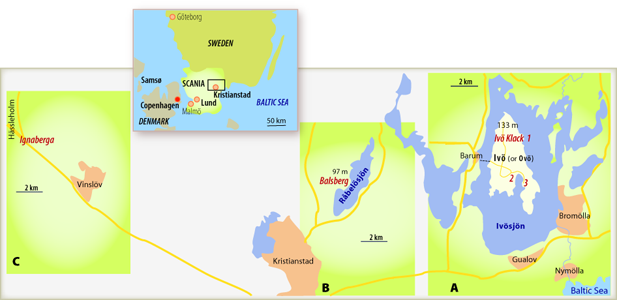
Click on thumbnail to enlarge the image.
Figure 1: Map of the main localities in Scania. Area of Interest outlined by rectangle. A. On Ivö island. (1) Ivö Klack, the type locality of Crania craniolaris. (2) the medieval church that was probably built by Archbishop The church was dedicated originally to Saint Ursula during the Catholic period and a spring below the steep river bank is still called Ursula's Spring. In the same location are the ruins of the Ivöhus castle which was also built by All that remains of the once magnificent castle are the ruins of the ground floor. (3) The Archbishop's cellar is located at Hovgården, 2 km southeast of the Ivö Church. B. Balsberg, the other type locality of Crania craniolaris. C. Ignaberga, the type locality of Isocrania egnabergensis (, 1781).

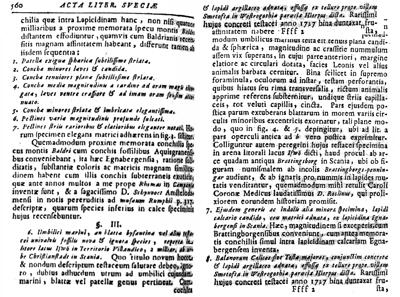
Click on thumbnail to enlarge the image.
Figure 2: Facsimile of p. 559-561 and figure of (1729).
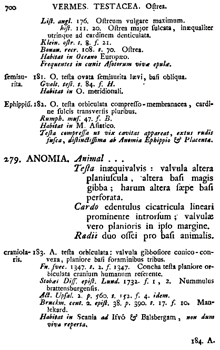
Click on thumbnail to enlarge the image.
Figure 3: Facsimile of p. 700 of (1758): original description of Anomia craniolaris.
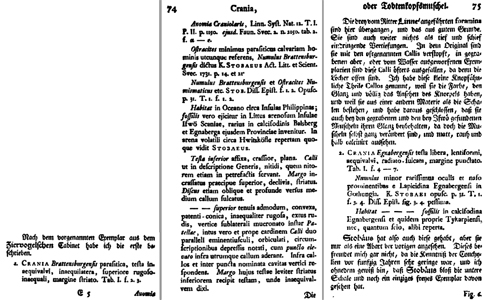
Click on thumbnail to enlarge the image.
Figure 4: Facsimile of p. 73 (part) - 75 of (1781).
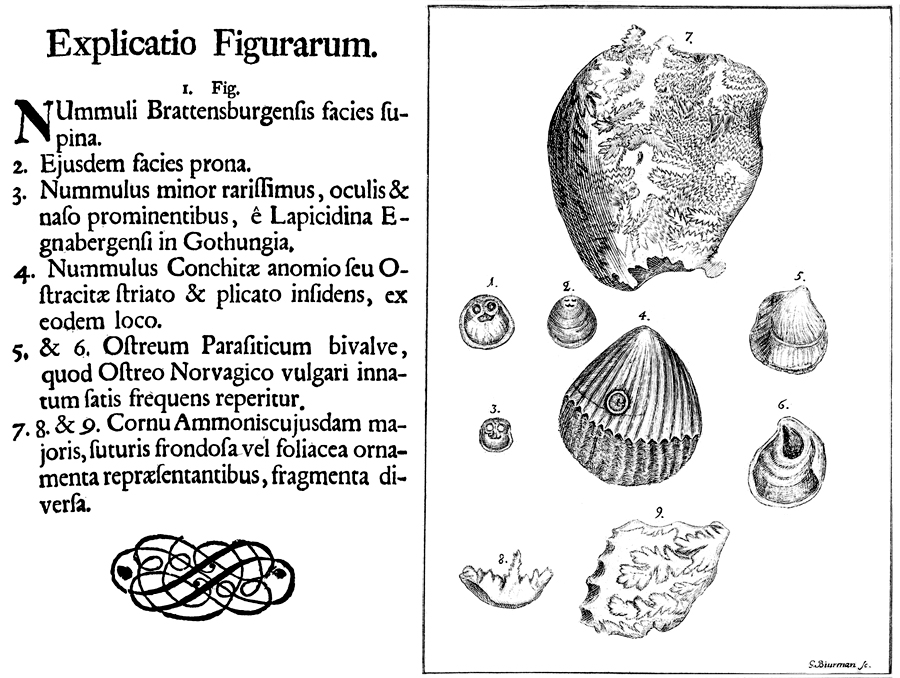
Click on thumbnail to enlarge the image.
Figure 5: Facsimile of Figure 1 (p. 25-26) of (1731). Explanation translated from Latin: 1. Brattensburg coins face bended backwards (=supina, that is internal side of the valve). 2. The same face turned forward (=prona, that is external side of the valve). 3. Small money very rare, eyes and nose prominent, from the stone-quarry of Ignaberga in Gothland. [Reproduction by permission of Staats- und
Universitätsbibliothek Göttingen – available at http://www.animalbase.uni-goettingen.de/zooweb/servlet/AnimalBase/home/reference?id=1730]
Nota: In English Nummulus [diminutive of nummus] means a small piece of money, a coin; and in French, "petit écu", un diminutif de nummus "pièce de
monnaie".
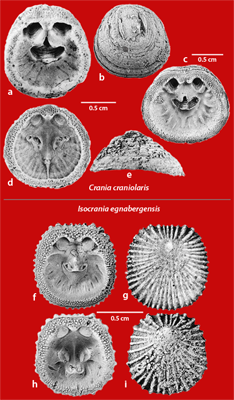
Click on thumbnail to enlarge the image.
Figure 6: Crania craniolaris (, 1758): a- ventral valve, interior; b- dorsal valve, exterior; c- ventral valve, interior; d- dorsal valve, interior; e- lateral. Isocrania egnabergensis (, 1781): f- ventral valve, interior; g- ventral valve, exterior; h- dorsal valve, interior; i- dorsal valve, exterior.
From Treatise on Invertebrate Paleontology (Fig. 96,1d–k Fig. 99, 1a–i), courtesy of and © 2000, The Geological Society of America and The University of Kansas.
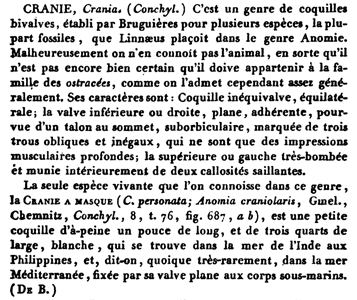
Click on thumbnail to enlarge the image.
Figure 7: Facsimile of the quotation of the section concerning Cranie à masque from (1818). In the same publication, this author has described Crania parisiensis, now Ancistocrania parisiensis and Crania antiqua.
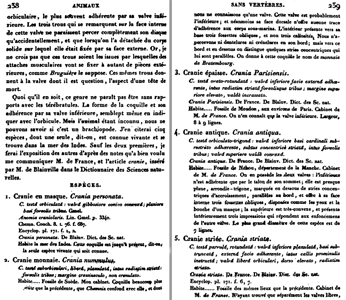
Click on thumbnail to enlarge the image.
Figure 8: Facsimile of p. 238-239 of (1819): description of Crania nummulus.